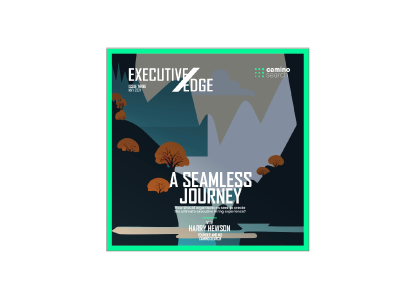

Issue Eleven, Part Three: Permanent Capital Trends
2024-10-11

Nathan Placks
Head of M&A and Corporate Development Practice
nathan@caminosearch.co.uk
Tampa Practice, USA
PERMANENT CAPITAL TRENDS
By Harry Hewson, MD, Camino Search
This article is the final edition of the Executive Edge three-part mini-series on M&A with Camino Search’s Head of M&A and Corporate Development Practice, Nathan Placks.
In parts one and two we discussed the different types of M&A plays, skills required for operating in acquisitive environments, and exit strategies. This article focuses on the growing presence of permanent capital and the factors behind it.
[HH] Permanent capital seems to be a common topic in your conversations at the moment, is it gaining more traction?
[NP] Absolutely. I’m seeing a huge shift to longer investment timelines and a stronger focus on sustainability across family offices, high-net-worth individuals, pension funds, and evergreen PE funds gaining more popularity.
Permanent capital provides an attractive alternative to traditional fund structures that emphasise rapid returns. Businesses are increasingly seeking flexible capital solutions without rigid timelines, and investors are beginning to shift their focus to long-term value over short-term gains.
Evergreen funds are not new within PE but I have seen them become increasingly active in recent years with firms such as HarbourVest Partners and Vista Equity Partners incorporating this approach into their portfolio strategy. These funds are great for so many reasons, with their increased return potential, ability to recycle and reinvest capital and reduced risk through diversification.
There is a similar trend within continuation funding from PE funds such as Hg Capital, whereby the PE firm extends the life of its investments by transferring certain assets into a new fund or vehicle.
[
HH] Working across both the European and North American markets, is there a difference in the prominence of permanent capital?
From my experience, permanent capital is much more present in the US. There are many more family offices and HNWIs in the US and therefore more access to the capital required.
Download PDF version
Click here[HH] Why do you think permanent capital is so attractive to investors and founders?
[NP] For investors, permanent capital offers several unique advantages over traditional investment models.
1) Long-Term Investment Horizon
Long-term investments without the pressure of short-term performance targets. Permanent capital doesn’t require capital to be returned to investors on a set schedule, allowing investors to focus on sustainable growth and value creation over time.This is great for family offices, pension funds, or sovereign wealth funds that are looking for steady returns over decades rather than quick profits.
2) Compounding Returns
The longer you hold, the bigger the returns. With a long-term or indefinite time horizon, permanent capital allows for the benefits of compounding returns to play out fully. Investors can let investments grow without the need to periodically liquidate.
I’ve spoken with permanent capital investors who are expecting venture-like return outcomes of more than 100x which would not be possible within the traditional majority investment lifecycle.
3) Less Liquidity Pressure
With permanent capital, there is less need to liquidate investments to return capital to investors at the end of a fund’s life. This frees managers from having to sell assets at inopportune times and hold onto investments through market cycles and realise higher returns.
4) Diversification
Permanent capital structures tend to be more diversified, since they are not limited by a specific strategy or investment horizon. This allows managers to invest in a wide range of assets, sectors, and geographies, providing broader risk mitigation for investors.
As for founders, most founders in my network nowadays seem to be leaning towards permanent capital as an alternative to conventional VC or PE investments.
5) Alignment of Vision
In traditional VC or PE setups, there is often significant pressure to scale rapidly and sell or go public so that investors can return capital to Limited Partners. Permanent capital gives founders the flexibility to make strategic, patient decisions in the best interest of the business that might not deliver immediate results but will pay off significantly in the long run.
6) Stability of Capital
Permanent capital provides a stable source of funding, which is crucial for founders looking to build resilient businesses. Traditional investors may push for rounds of funding that dilute ownership or create instability. With permanent capital, founders have the financial support needed to execute their vision without constantly worrying about raising more money or giving up significant equity to appease investors.
With permanent capital, businesses can reinvest their profits to fuel further growth rather than distributing profits to investors on a tight schedule. Founders can focus on scaling, innovation, or expanding into new markets without the constant pressure of delivering immediate financial returns.
7) Control Over the Business
Founders partnering with permanent capital investors typically retain more control over their company. Since permanent capital investors are not looking for an immediate exit, they tend to interfere less with day-to-day decisions and focus more on supporting the long-term strategy. This allows founders to stay true to their vision, maintain control over the direction of the business and protect their legacy.
[HH] What are the benefits for C-Suite executives or other senior business leaders?
[NP] The benefits of permanent capital aren’t limited to investors or founders, senior leaders within the business will also reap the benefits.
1) Job Security and Leadership Continuity
In businesses backed by short-term investors, leadership changes can be frequent, especially if the company is sold to new owners or goes public. With permanent capital, leaders often enjoy greater job security and continuity in leadership. Investors are typically not looking to replace management teams as long as the company is performing well, which can lead to greater stability for teams and give them more development opportunities..
Upside
2) Senior business leaders operating in permanent capital structures can expect significant returns, often of 15x to 20x on their money at work across a 15+ year lifecycle. In traditional models, compensation might be tied to hitting specific financial metrics tied to an impending exit; permanent capital structures have compensation and incentive structures designed to reward sustainable performance over time and focus on building a great business.
COMING NEXT
In the next article, the focus shifts away from M&A to explore the topic of interim CFOs and exit readiness.
Executive Edge is Camino Search’s bi-weekly column, showcasing our insights on the market, talent
acquisition and business strategy, authored by Founder and Managing Director, Harry Hewson.


